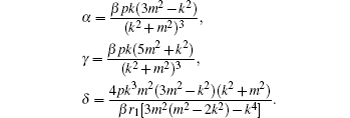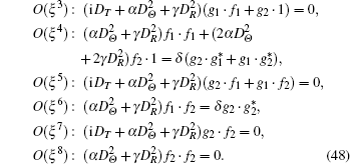† Corresponding author. E-mail:
Project supported by the National Natural Science Foundation of China (Grant No. 41406018).
In the past few decades, the (1+1)-dimensional nonlinear Schrödinger (NLS) equation had been derived for envelope Rossby solitary waves in a line by employing the perturbation expansion method. But, with the development of theory, we note that the (1+1)-dimensional model cannot reflect the evolution of envelope Rossby solitary waves in a plane. In this paper, by constructing a new (2+1)-dimensional multiscale transform, we derive the (2+1)-dimensional dissipation nonlinear Schrödinger equation (DNLS) to describe envelope Rossby solitary waves under the influence of dissipation which propagate in a plane. Especially, the previous researches about envelope Rossby solitary waves were established in the zonal area and could not be applied directly to the spherical earth, while we adopt the plane polar coordinate and overcome the problem. By theoretical analyses, the conservation laws of (2+1)-dimensional envelope Rossby solitary waves as well as their variation under the influence of dissipation are studied. Finally, the one-soliton and two-soliton solutions of the (2+1)-dimensional NLS equation are obtained with the Hirota method. Based on these solutions, by virtue of the chirp concept from fiber soliton communication, the chirp effect of envelope Rossby solitary waves is discussed, and the related impact factors of the chirp effect are given.
It is generally known that the ocean and atmosphere move endlessly in complex patterns and on diverse scales. To discuss the whole dynamics of this enormous spectrum of motions is almost impossible. So our special interest is the so-called large scale motions which are prominently affected by the rotation effect of the earth. Among these large scale motions, the nonlinear Rossby waves have attracted considerable attention from the oceanic and atmospheric field in recent years. Long[1] first found the Rossby solitary waves in the westerly shear flow in the 1960s, then Benney,[2] Redekopp[3] and other investigators pushed the research forward. In the 1970s∼1980s, driven by blocking dynamics, the nonlinear theory of Rossby solitary waves achieved rapid development and formed the solitary waves theory, dipole waves theory, and envelope solitary waves theory. For the Rossby solitary waves, some weakly nonlinear models for the evolution of Rossby solitary waves have been extensively studied in the past. Among these, the Korteweg–de Vries (KdV) equation,[4–6] modified KdV equation,[7,8] and Boussinesq equation[9] were derived to describe the classical Rossby solitary waves; the Benjamin–Ono equation[10,11] was obtained to show the algebraic Rossby solitary waves with non-uniform horizontal shear of zonal flow in infinite depth fluid, while the Intermediate Long Wave equation[12,13] was used to describe the condition in finite depth fluid. For the envelope Rossby solitary waves, the nonlinear Schrödinger (NLS) equation was first obtained by Benney[14] and Yamagata,[15] respectively. Later, Luo[16] also derived the NLS equation to express the envelope Rossby solitary waves and showed that the atmospheric blocking in the mid-high latitudes could be explained better by employing a dipole envelope Rossby solitary wave. With the development of theory, the higher order NLS equation[17] was derived to describe the dynamic behavior of envelope Rossby solitary waves. However, all the above-mentioned models are (1+1)-dimensional and used to describe the propagation of Rossby solitary waves or envelope Rossby solitary waves in a line, which are not enough to reflect the evolution of Rossby solitary waves in the real ocean and atmosphere. It seems that few previous researches involved the problem. The purpose of this paper is to obtain a new (2+1)-dimensional dissipation nonlinear Schrödinger equation (DNLS), which is more suitable to describe the evolution of envelope Rossby solitary waves in the real ocean and atmosphere. Especially, due to the dissipation character of the real oceanic and atmospheric motion, we will embed the dissipation effect in the study.
On the other hand, in the fiber soliton communication field, the chirp effect is proposed to express frequency modulation in the process of transmission. The interaction of the nonlinear and dispersive effect can cause the excursion of the center wave and lead to chirp effect. Drawing lessons from the chirp concept in fiber soliton communication, Song[18] investigated the chirp effect of an internal wave, while we will discuss the chirp effect during the propagation of envelope Rossby solitary waves.
Besides the above-mentioned problems, we shall use these methods to solve the soliton equations, such as the first integral method,[19] similarity transformation,[20] Jacobi elliptic function expansion method,[21] Bäcklund transformation method,[22] Darboux transformation method,[23] and so on. In the paper, we will derive the one-soliton and two-soliton solutions of the (2+1)-dimensional NLS equation by employing the Hirota method[24] and analyze the chirp effect based on the analytical solutions.
This paper is organized as follows. In Section 2, from the rotational potential vorticity-conserved equation with dissipation, by constructing a (2+1)-dimensional stretching transformation of time and space, a (2+1)-dimensional DNLS equation is derived, which is a generalization of the (1+1)-dimensional NLS equation obtained by the former. In Section 3, by theoretical analyses, the character of the (2+1)-dimensional envelope Rossby solitary waves under the influence of dissipation is studied. Section 4 will be devoted to investigating the one-soliton and two-soliton solutions of the DNLS equation by using the Hirota method and dissipation effect. Based on these analytical solutions, the chirp effect of envelope Rossby solitary waves will be discussed in Section 5. Some conclusions are given in the last section.
The basic equation of motion used in previous studies is the following non-dimensional quasi-geostrophic equation in the form of potential-vorticity:


Because of the multiple time and space scales feature of Rossby waves, in order to consider the nonlinear effect, we take the following slow scales:

Based on the WKB method, we can expand the stream function as


Here for the sake of achieving a balance between nonlinearity and turbulent dissipation


Substituting Eqs. (



We look for an amplitude equation, so in the order of ɛ1, assuming ψ1 is periodic in θ and t in the form of

Substituting Eq. (




In order to obtain the governing equation of complex amplitude A, we need to consider the higher order problem. At the next order, O(ɛ2), by introducing Eq. (




To determine ψ2, we then substitute the solution (





Then multiply by ϕ1 and integrate from 0 to r1 with respect to r, by virtue of the boundary conditions, it turns out that the nonlinear equation for the evolution of complex amplitude A satisfies the following form




The theoretical model of envelope Rossby solitary waves has been derived in the above section, now we will discuss the evolution of envelope Rossby solitary waves with the dissipation effect. As we know, many physical characteristics of solitary waves remain invariant during the various processes which happen in the physics world; these invariant physics characteristics are called conservation laws. Conservation laws play an important role in the research on the unsteady problem of waves. We will focus on the change of conservation laws of envelope Rossby solitary waves under the influence of dissipation.
In the following, assuming A,A* → 0 as |R| → +∞ and the values of A,A* at Θ = 0 equal those at Θ = 2π, where the superscript * stands for the complex conjugate.
The complex conjugate equation of Eq. (





In the following, performing equation (







Finally, let us continue to consider the third conservation quantity. equation (


By Eq. (
As mentioned above, three conservation quantities of (2+1)-dimensional envelope Rossby solitary waves have been derived. Furthermore, the conservation laws are destroyed due to dissipation, which shows that the dissipation has an important influence for the evolution of (2+1)-dimensional envelope Rossby solitary waves.
In the above section, we have analyzed the variation of conservation laws under the influence of the dissipation effect and revealed the impact of dissipation on the evolution of envelope Rossby solitary waves. This section will be devoted to discussing the chirp effect of envelope Rossby solitary waves and assume that the dissipation is absent. In order to make the reader understand the content more clearly, it is necessary to explain the concept of chirp. The concept of chirp comes from the optical soliton communication area and is also called the frequency modulation effect. During the propagation of the wave, due to the nonlinear and dispersion effect, the excursion phenomenon of the center wave will occur, i.e., the chirp effect will occur. Here drawing lessons from the chirp concept of optical soliton communication, we will study the frequency modulation effect of (2+1)-dimensional envelope Rossby solitary waves. It is very meaningful for recognizing the character of envelope Rossby solitary waves. In order to accomplish this aim, we must explore the analytical solutions of the (2+1)-dimensional NLS equation. As noted previously, many methods have been proposed to solve soliton equations; here we adopt the Hirota method.
Neglecting the dissipation effect (λ = 0), equation (









In fact, we can also derive the two-solitons solution of Eq. (





After similar procedure and tedious calculation, we have



In the following, we will study the chirp effect of the (2+1)-dimensional envelope Rossby solitary waves based on the solution (





Next, focusing on the chirp caused by nonlinear, then equation (








In conclusion, the chirp effect depends on the initial amplitude, the critical value is given in Eq. (
In the paper, based on the multiscale and perturbation method, by constructing a new (2+1)-dimensional multiscale transform, the (2+1)-dimensional dissipation NLS equation to describe envelope Rossby solitary waves propagating in a plane under the influence of dissipation is derived. By theoretical analysis, the conservation laws of (2+1)-dimensional envelope Rossby solitary waves is obtained. Furthermore, their variation state under the influence of dissipation reveals the impact of dissipation on the evolution of envelope Rossby solitary waves. By employing the Hirota method, after tedious calculation, the one-soliton, two-solitons solutions of the (2+1)-dimensional NLS equation are given. One-soliton solution is used to discuss the chirp effect and two-solitons solution possesses potential application in the inaction of envelope Rossby solitary waves. Finally, with the help of the one-soliton solution, the chirp effect of (2+1)-dimensional envelope Rossby solitary waves is studied. By analysis, we find the critical value of the chirp effect and the related factors with chirp effect, i.e., the polar angle direction wave number k, the frequency of Rossby waves Ω, the Coriolis force parameter β as well as the modal number m of (2+1)-dimensional envelope Rossby solitary waves.


